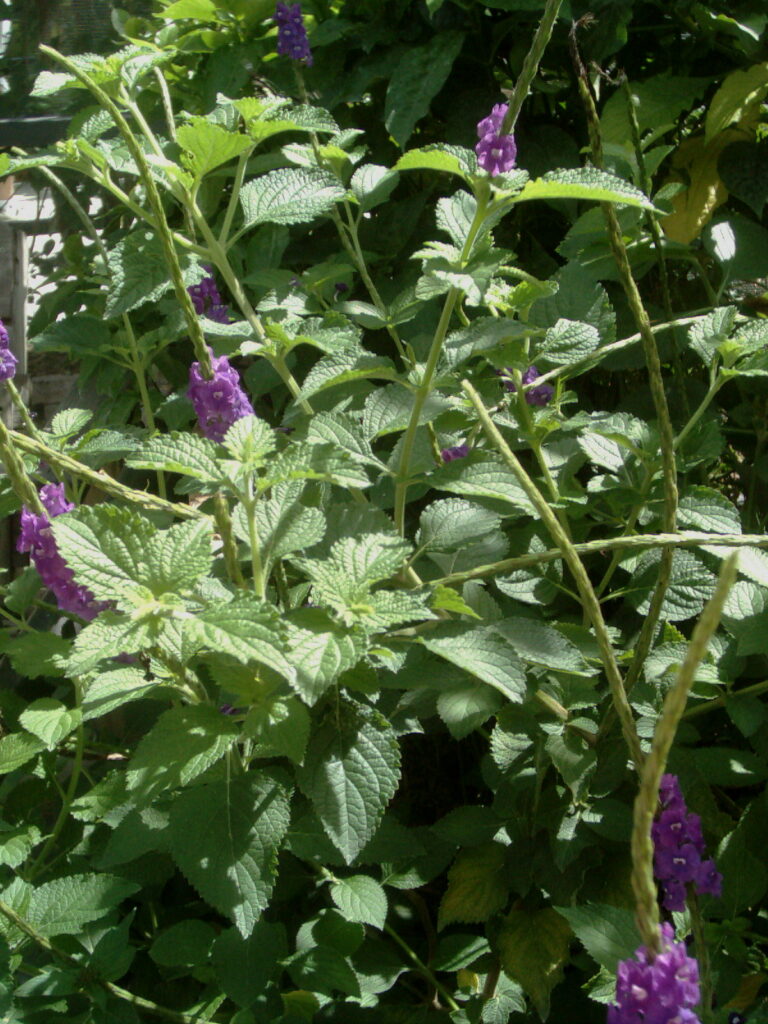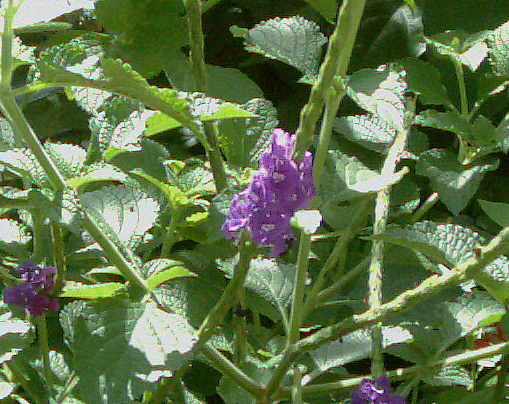A visit to the past through email and a discussion about plant identification and native plants. Porterweed is the star of this show!
Whoops, what is that plant again?
The email was bound to come, and it did, about ten days after my Plant Profile: Porterweed with blue-purple flowers. The email said, “(We) identified your photo as the non-native, old world bule, Stachytarpheta urticifolia (not) the Stachytarpheta jamaicensis that is the native porterweed. I feel confident in that ID; I just completed the Native Plant Landscape course…” said Susan from Vero.

Did I make a misidentification? Definitely, a possibility. My husband was fond of saying, “You are truly a horticulturist; you know cultivated plants, but when it comes to natives, get help!” So, asking for help was in order, and off went email requests with copies of the photos of the Stachytarpheta or Porterweed in question.
We are blessed to have wonderful, helpful folks here in Florida working with plants. The first response came from Richard P. Wunderlin, Ph.D., who was at the time from the University of South Florida and Director of the Atlas of Florida Vascular Plants. “The plant is most likely Stachytarpheta cayennensis. That species is the one that is most often commercially available,” said Wunderlin.
Wait a minute, Stachytarpheta cayennensis? A third possibility? No, more extensive taxonomic research found that the plant once identified as Stachytarpheta urticifolia, an old-world species is Stachytarpheta cayennensis, a new-world species. For more information, Dr. Wunderlin referred me to “Roger Hammer, (who was at the time), Director of Castellow Hammock Nature Center of the Miami-Dade Parks Department, (he) is the most knowledgeable about Stachytarpheta.”
Another round of emails and a phone conversation with Roger Hammer helped me understand more about porterweed species. Hammer said, “Assuming that the flowers are darker blue than what they appear to be in the images you sent and that each individual flower only lasts a single day, then the plant in question is, indeed, Stachytarpheta cayennensis. One characteristic of this plant is the bullate (quilted) leaf surface and the numerous teeth along the leaf margins that are mostly outward pointing. The native S. jamaicensis has fewer and coarser teeth with more forward pointing.” Oh My! Maybe I was wrong; the plant in my picture is most likely Stachytarpheta cayennensis or a hybrid between S. cayennensis and S. jamaicensis, a common occurrence. There are distinct differences between the plants and where they came from originally. But, I hear you ask, what does this mean to me and my Florida landscape?
More on Yard Doc Carols’ trouble with Porterweed…
There is no doubt, Porterweed is the star of this show. Roger Hammer, a Porterweed expert, confirmed that the plant is not Stachytarpheta jamaicensis. Hammer said, “Carol, the native S. jamaicensis is a low-growing plant, usually no more than 2 feet high with branches spreading out 3 feet or more. It has coarse teeth on the leaf margins that tend to point more outward than forward. S. jamaicensis makes a great ground cover. The non-native Stachytarpheta cayennensis grows much taller; I have seen it top 5 feet.”

I took a picture of the plant in question, which was taller than 2 feet. However, Hammer went on to tell me that there have been hybrids between the 2 plants which exhibit some characteristics of both. The plant I took a picture of has larger flowers of a lighter color than those expected on the non-native S. cayennensis. Maybe my plant is a hybrid; it will be difficult to tell which Stachytarpheta I have captured in the picture.
OK, so what? Using native plants in landscapes has become a topic of discussion among gardeners and planners. Native plants can bring much to the table. Local native plants are adapted to the climate. Their use is reported to increase biodiversity, attract wildlife, conserve natural resources, and reduce pesticide use and excessive water.
All plants have a range or conditions that suit their growth, i.e., grow bougainvillea in the sun, pickerelweed on the edge of ponds, and geraniums in the winter. In other words, choose the plant that matches the site conditions. A native plant will fail to thrive or require more resources if planted in the wrong place. Is it still native if you water it more often or treat it with excessive pesticides? Unfortunately, many of us have inherited a landscape already planted and/or built on fill soils, and it is tough to find a native plant that thrives under those conditions.
Porterweed and native plants for Florida Landscapes
Many who know more about the subject have yet to answer the question of what is a native plant adequately. Some had said a plant is native if it was established in the location before the Europeans arrived. Others state that a plant is native if it came without human intervention. For me, this is a tough call; the issue or “native” depends on the site and the use of the plant. Not all plants are created equal, and that includes native plants. What is appropriate in an urban landscape will differ significantly from what is used for ecological restoration. For an in-depth look at this discussion, visit the Florida Native Plant Society’s website.
Porterweed is the star of this show; it is the plants that started us off on this journey, Stachytarpheta cayennensis and Stachytarpheta jamaicensis are distinct plants, and Susan from Vero called me on a misidentification of a Stachytarpheta in a photo accompanying the Plant Profile of May 14. The two plants come from different areas originally, though they do hybridize. S. cayennensis is found throughout Central and South America. It grows taller than our native, S. jamaicensis. Both can be weedy and spread readily in gardens and landscapes.
Is it “wrong” to grow the non-native S. cayennensis or any non-native species? If you are a purist and advocate only using native plants, yes. However, I believe there is room for using many other plants in the Florida landscape as long as you remember my mantra – match the plants’ growth requirements to the site conditions. Roger Hammer, Porterweed expert, added, “I am not a purist, S. cayennensis isgreatfor gardeners. It attracts tons of butterflies even though it tends to pop up everywhere.”
If you are interested in native plants for South Florida, one of the most outstanding websites I have come across in a long time was suggested by Hammer. The Institute for Regional Conservation provides a search by zip code. Simply input your code, and out pops a list of what is native to your area.
It is a good day when I learn something, and I do so most days. Today, I learned more about Porterweed and native plants. I hope you did too. I also hope that you will be aware of the specific conditions of your landscape and choose plants that match the site, and strive to plant natively where appropriate.
Leave a Reply